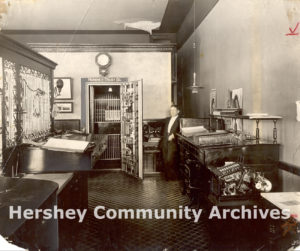Providing for the Town’s Financial Needs: Hershey Trust Company

April 1905: Construction for the new chocolate factory had been completed during the winter and the factory was gearing up for full production. Construction of the Cocoa House had recently been completed. It provided housing and meals for single men as well as office space for a variety of businesses needed by the new town. First and foremost Milton Hershey needed a bank to handle the varied finances of the new community. Earlier in the year he had applied to the state for permission to establish a trust company that would serve as the community’s bank. A state charter was granted on April 27, 1905 and Hershey Trust Company opened for business on June 15, 1905 in offices located in the Cocoa House. A published brochure advertised a wide scope of banking services. In addition to handling the Hershey business payrolls, the Trust Company offered savings accounts, mortgages, and commercial and personal loans.
The decision to establish a trust company rather than a bank was made after Milton Hershey sought advice from the Northern National Bank of Lancaster, PA. In his reply, E.J. Ryder, the Northern National cashier, suggested that in addition to taking mortgages, a trust company would have the added advantage of doing fiduciary business.
Still, in 1905 Milton Hershey’s town was more of an idea than an actuality. Though the chocolate factory began full operations that summer, little else was operating in town. Another year would pass before the community was officially named, when the United States Postmaster granted Milton Hershey permission to establish a new post office.
Hershey Trust Company quickly became the town’s financial center, playing an important role in financing Milton Hershey’s construction and development plans. It was instrumental in the growth and development of the town, advertising mortgages in ads that encouraged people to build a home in the new community. The Trust Company advertised frequently in the local papers, encouraging residents to start savings accounts and to plan for the future. To broaden its accessibility, special deposit stations were established on Hershey trolleys. Specialized savings accounts, such as Christmas Savings Clubs, were clever gimmicks promoted by the Trust Company to encourage new account business. Bank accounts were also promoted as a means to future retirement security.
Hershey Trust Company continued to serve as the community’s bank for the next two decades. However, in 1918, the Trust Company took on a new responsibility when Milton Hershey transferred his ownership of the Hershey Chocolate Company, then valued at $60 million, to the Hershey Industrial School Trust fund (today Milton Hershey School).
With Milton Hershey’s gift, the Trust Company needed to direct more of its efforts toward the management of the School Trust’s assets. In particular, the Trust Company assumed responsibility for Milton Hershey’s land assets, by then more than 10,000 acres of land in and around Hershey as well as his other financial investments. As the Trust Company assumed these new responsibilities, it became apparent that the town needed a new financial institution to provide the more traditional banking services for the community. To free the Trust Company for its duties as Trustee of the School Trust, the Hershey National Bank, a nationally chartered institution, was established in 1925 to handle the town’s commercial banking needs.
